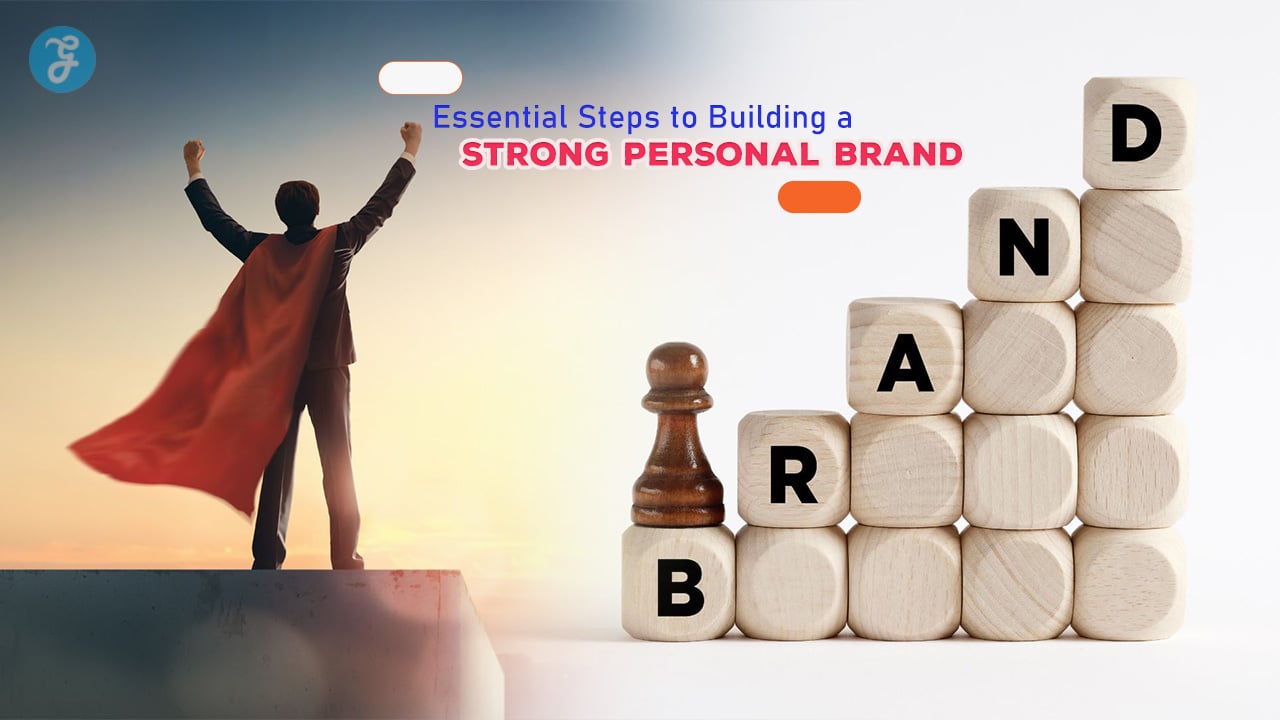In today’s competitive landscape, whether you’re a freelancer, entrepreneur, or corporate professional, building a strong personal brand is essential. Your personal brand represents how you project yourself to the world, both online and offline.
It’s what people think of when they hear your name, the qualities they associate with you, and the expertise they believe you possess.
In this article, we will break down the 10 essential steps to building a powerful personal brand. These steps will guide you from defining your unique identity to establishing an online presence, creating valuable content, and ensuring your brand evolves with time.
Let’s get started!
What is a Personal Brand?
A personal brand is more than just a logo or a tagline. It’s the combination of your skills, experiences, values, and how you present yourself to your audience. In essence, your personal brand is your unique identity and the way others perceive you.
It’s a reflection of who you are, what you stand for, and the value you bring to your field or industry.
Why Building a Personal Brand is Crucial for Success
Building a personal brand is key to establishing credibility and authority in your niche. A strong personal brand can open up opportunities for career advancement, partnerships, speaking engagements, and business growth.
It helps you stand out from the competition, allows you to build trust with your audience, and positions you as an expert in your field. Whether you’re looking to climb the corporate ladder or grow your own business, a strong personal brand is a must.
The 10 Essential Steps to Building a Strong Personal Brand
Here are the 10 essential steps to build a strong personal brand.
1. Define Your Unique Value Proposition (UVP)
Your Unique Value Proposition (UVP) is the core of your personal brand. It’s what differentiates you from others and highlights the unique qualities, skills, and strengths that set you apart.
Defining your UVP is crucial because it gives you clarity on what you bring to the table and why people should pay attention to you. Without a clear UVP, your brand may lack focus, and it becomes harder for others to understand what makes you special.
Steps to Define Your UVP
To define your UVP, start by reflecting on your core skills and strengths. Ask yourself: What am I exceptionally good at? What do others consistently come to me for advice on?
Once you have clarity on your unique strengths, identify your target audience’s needs and pain points. Align your UVP with the problems your audience faces and how you can solve them.
Remember, your UVP should communicate the value you provide and why it’s different from others in your field.
2. Identify Your Target Audience
A personal brand is not effective if it doesn’t resonate with the right people. Identifying your target audience is crucial because it allows you to tailor your message, content, and services to those who will benefit most.
Knowing your audience ensures that your brand speaks directly to the people you want to influence, attract, or serve.
Steps to Identify Your Audience
To identify your target audience, begin by analyzing who you want to connect with. Are you trying to reach professionals in a specific industry? Entrepreneurs? Consumers? Consider the demographic and psychographic characteristics of your audience, such as age, gender, job role, and interests.
Use online tools and platforms like social media analytics to understand your audience’s behavior and preferences. The more you understand your audience, the more effectively you can position your brand to meet their needs.
3. Build a Clear and Consistent Brand Message
Your brand message should clearly communicate who you are, what you stand for, and the value you provide. Consistency is key to ensuring your message resonates across all platforms and touchpoints.
Without clarity and consistency, your audience may become confused about what you represent, which can dilute your brand’s effectiveness.
Crafting Your Brand Message
To craft your brand message, start by defining your core values and principles. What do you want to be known for? What do you want your audience to take away from interacting with you? Create a concise brand statement that reflects your mission and aligns with your UVP.
Then, ensure that your messaging remains consistent in tone, style, and content across your website, social media profiles, emails, and other communication channels. Consistency builds trust and reinforces your brand in the minds of your audience.
4. Develop a Professional Online Presence
In today’s digital age, your online presence plays a pivotal role in building a personal brand. Whether it’s through social media platforms like LinkedIn, Twitter, or a personal website, your online presence is often the first place potential clients, employers, or partners will encounter your brand.
A well-developed online presence allows you to showcase your expertise, engage with your audience, and build a strong network.
Steps to Create an Impactful Online Presence
Start by optimizing your profiles on major platforms like LinkedIn, Twitter, and Instagram to reflect your brand message and UVP. Make sure your bios, photos, and content align with the personal brand you want to create.
Consider creating a personal website or blog where you can showcase your portfolio, write about industry trends, or share insights. Remember to keep your online profiles professional, up-to-date, and consistent in terms of visuals and messaging.
5. Create Valuable and Relevant Content
Content is a powerful tool for building your personal brand. By consistently sharing valuable, relevant, and informative content, you can position yourself as an expert in your field and gain the trust of your audience.
Content also helps you demonstrate your knowledge, skills, and unique perspectives, which strengthens your authority.
Developing a Content Strategy
To develop a content strategy, start by identifying the type of content that resonates with your audience. This could include blog posts, articles, videos, podcasts, or social media updates. Your content should address the problems, questions, or challenges your audience faces while aligning with your expertise.
Plan your content calendar to ensure regular posting, and aim to provide actionable insights or valuable information that sets you apart from others in your field.
6. Network and Build Relationships
Building relationships is an essential part of growing your personal brand. Networking allows you to connect with industry peers, potential collaborators, mentors, and clients who can help you expand your brand’s reach.
By engaging with others, you not only create valuable partnerships but also increase your visibility in your industry.
How to Build Authentic Connections?
To build meaningful connections, be proactive in reaching out to people within your industry. Attend networking events, join relevant online communities, and engage with others on social media.
It’s important to offer value in your interactions—whether it’s through sharing your expertise, offering support, or simply being an active participant in conversations. Genuine connections are key to expanding your influence and growing your brand.
7. Maintain Authenticity
One of the most critical components of a successful personal brand is authenticity. People are drawn to individuals who are genuine, relatable, and transparent.
By being authentic, you create trust and loyalty with your audience, which is essential for building long-term relationships. Your audience should feel that they know the real you.
Tips to Stay Authentic While Building Your Brand
To remain authentic, be true to your values and beliefs in all of your communications. Avoid exaggerating your achievements or pretending to be someone you’re not.
Stay consistent in your message, and reflect your genuine self in all your interactions—both online and offline. By being yourself, you attract an audience that resonates with who you truly are, which helps build a loyal following.
8. Leverage Testimonials and Social Proof
Social proof, such as testimonials, endorsements, and recommendations, is one of the most powerful ways to build credibility. When people see that others trust and value your expertise, they are more likely to view you as a reliable and knowledgeable professional.
Social proof adds legitimacy to your brand and helps convince potential clients or employers of your value.
Gathering and Displaying Testimonials
To gather testimonials, ask clients, colleagues, or collaborators to share their positive experiences working with you. Showcase these testimonials on your website, social media profiles, and LinkedIn recommendations.
If you’ve received awards, certifications, or positive media coverage, display them prominently to further strengthen your credibility and demonstrate your expertise.
9. Continuously Improve and Evolve Your Brand
Personal branding is not something that you build once and forget. As your career grows, so should your brand. Industries change, new skills are developed, and your goals may evolve, all of which require regular updates to your personal brand.
Staying static can cause your brand to lose relevance, so it’s important to assess and adapt continuously.
How to Assess and Update Your Personal Brand?
To ensure your personal brand stays relevant, periodically evaluate your brand’s impact. Gather feedback from your audience or peers, track your online presence, and assess whether your brand message still aligns with your current goals. Stay updated on industry trends and be open to refining your brand as needed. Whether it’s learning new skills, refreshing your content strategy, or expanding your online presence, always look for ways to improve and grow.
10. Stay Consistent and Persistent
Building a strong personal brand requires time, effort, and persistence. Consistency is key to ensuring that your brand remains top-of-mind for your audience.
If you post sporadically or engage inconsistently, your audience may lose interest, and your brand can become diluted. Persistence is crucial to maintaining your brand’s momentum and continuing to grow your influence.
Tips to Stay Consistent in Your Branding Efforts
To stay consistent, create a routine for regular content creation, engagement, and self-promotion. Use tools like social media schedulers or content calendars to plan and manage your efforts. Regularly interact with your audience and stay active in relevant communities.
It’s also important to maintain consistency in your brand messaging, visuals, and tone to reinforce your identity over time. By staying the course, you’ll build a brand that stands the test of time.
Conclusion
Building a strong personal brand is a multifaceted process that requires clear messaging, a professional online presence, valuable content, and authentic networking.
Each of the 10 steps—defining your UVP, identifying your audience, maintaining authenticity, and continuously improving your brand—plays a vital role in shaping how you’re perceived in your industry.
A strong personal brand isn’t built overnight, but with dedication, persistence, and the right strategies, you can create a brand that reflects your true self, resonates with your audience, and helps you achieve your goals.
It’s an investment that pays off in the form of new opportunities, stronger relationships, and a lasting professional reputation.











































